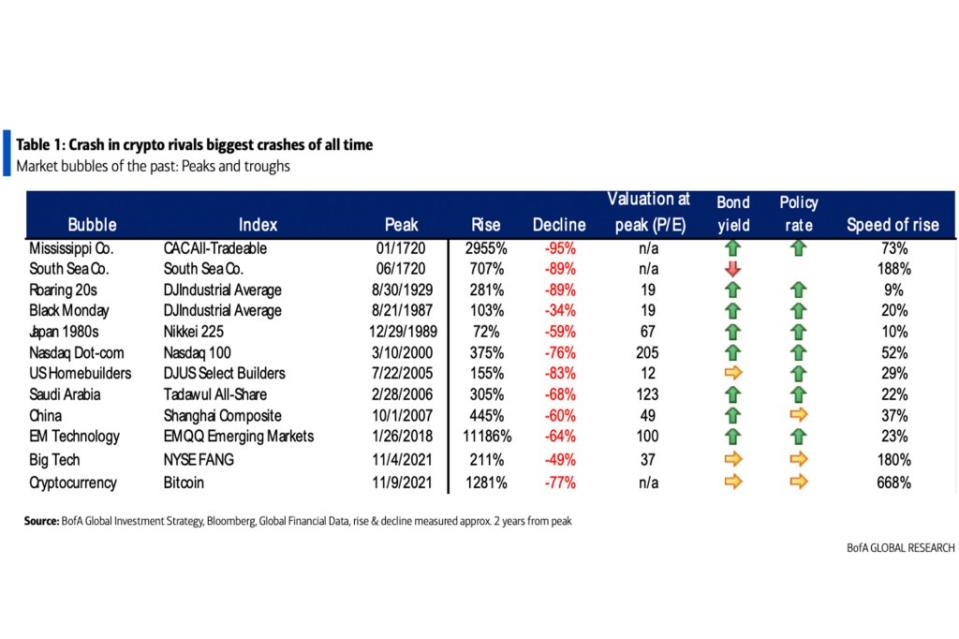Bitcoin is now the fifth largest extinction of all time, says BofA, with a shocking chart of the past 50 years in finance.
The crypto industry recognizes the cold of winter.
Bitcoin is experiencing one of the biggest crashes in history – it’s clear. But Bank of America Research’s Flow Show research note has crunched the data and put it in historic terms: It’s the fifth-worst collapse of an asset in financial history, nearly as large in scale as the Mississippi & South Sea Co. History buffs would know that episode better as the South Sea Bubble, and it was so long ago—the early 18th century—that the United States did not yet exist and Britain was embroiled in the War of the Spanish Succession.
Bitcoin, which makes up 41% of the crypto market, has hit lows not seen since the depths of the pandemic two years ago. And while it rallied after May’s Crypto Winter, a market downturn is back in full force with FTX’s implosion leading to the crypto exchange filing for bankruptcy and founder and CEO Sam Bankman-Fried stepping down — a far cry from a few months ago when he was compared to JP Morgan for his attempted bailouts of distressed firms.
BofA’s research, based on Bloomberg data, finds Bitcoin’s fall to be the fifth biggest on record – and by far the biggest crash since the 1970s.

Bitcoin has seen a 77% decline from its peak trade of $70,000 last November in the wake of FTX’s fall. Meanwhile, the crypto market cap has fallen from $3 trillion to $900 billion.
It’s reminiscent of the dotcom bust two decades ago, which BofA estimates is down 76% (just 1% lower than Bitcoin’s fall) from its peak in March 2000. The dotcom bubble was fueled by investments in Internet companies from the day the Internet was new, during a bull market in the 1990s. The Nasdaq index grew rapidly, but in 2000 the bubble burst when companies that had raised a lot of money but didn’t have much in the way of a business plan basically just ran out of money. The Nasdaq’s quintuple fell with the crash, and billions of dollars were lost. Crypto critics argue that the similarities are obvious.
Another big bubble that just beats out Bitcoin is the end of the Roaring 20s and “Black Monday”, the stock market crash that triggered the Great Depression.
The economic events of 100 years ago also share similarities with today. After World War I, the US government spent more than it got back in tax revenue, and high inflation followed. However, American industrial power created a flood of jobs as the country emerged as a major international player.
Historians such as Liaquat Ahamed (who won a Pulitzer for his portrayal of central bankers of the Great Depression, Lords of Finance) argues that the imbalance in global trade caused by the use of the gold standard, on the one hand, and America actually having most of the world’s gold, confused central bankers’ response to the crash and worsened the recession into a depression; again, it’s not unlike today’s extraordinarily strong dollar as the world’s reserve currency. The Dow Jones Industrial Average plunged 89%, BofA calculates, putting even Bitcoin’s fall to shame.
In recent years, we’ve seen stocks of US homebuilders crash, falling 83% from a peak in 2005, based on BofA’s calculations. After the peak, an era of rapid growth ended within three years, and the financial crisis of 2008 followed.
Bitcoin has fallen about 3% in the last 24 hours and 19% in the last week – it is currently trading at around $16,800.
This story was originally featured on Fortune.com
More from Fortune:
The US housing market will see the second biggest correction since the Second World War – when can we expect the bottom of house prices
Sam Bankman-Fried’s failed crypto empire ‘was run by a bunch of kids in the Bahamas’ who all dated each other
The COVID cases are increasing again this autumn. Here are the symptoms you should look for
I had to be an overachiever to escape homelessness and land a six-figure tech job. Here’s what I think about quietly quitting.


